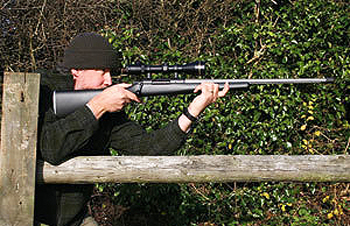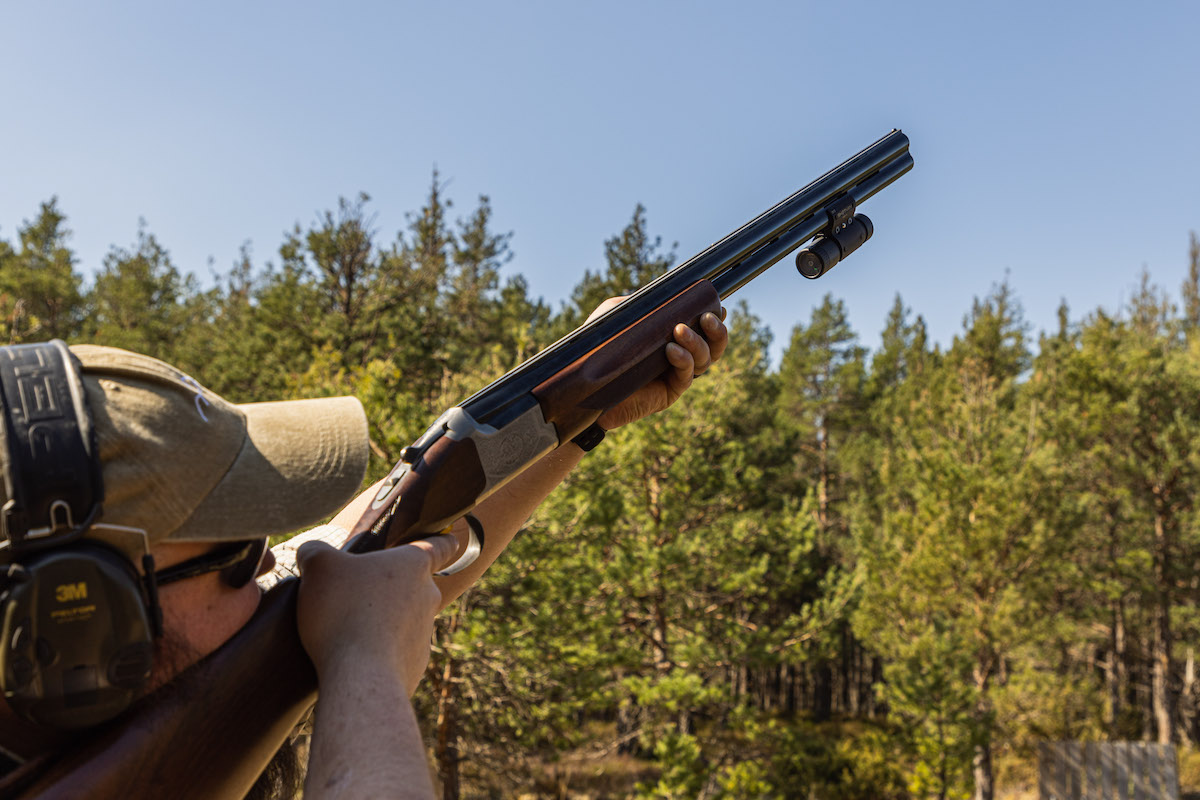Gun reviews: RPA International GP Hunter rifle

Gun reviews: RPA International GP Hunter rifle
Gun reviews: RPA International GP Hunter rifle.
The RPA International GP Hunter rifle is a superbly engineered and accurate rifle that is excellent for deerstalking or fox work.
I use an RPA Quadlite-actioned rifle in the course of my ballistics testing, primarily due to the overall quality of the action and the very strong construction.
The GP Hunter comes in either sporter stock trim or TH as the thumbhole variety.
Priced at less than £2,500, this is a near custom-built rifle without the lengthy wait normally associated with such items.
Usually when you buy a new standard factory rifle you may think that a better trigger or a more solid ergonomic stock would improve things, but the RPA Hunter needs no refinement.
All the components are designed to work in harmony with one another.
Bolt and action
You can instantly see the RPA’s target pedigree in the action design. It is substantial, to say the least, and is available in left- or right-hand configuration with the GP stock.
The main body is a full 6.5in long and made from high-tensile steel with a super-hard, satin-black finish that has pretty good corrosion resistance in use.
There are two retaining screws to the stock and the rounded exterior profile is only broken by a slim ejector port. The front of the action face has a slot so that the separate recoil lug locates and thus resists movement. It’s also square and substantial enough to aid in a solid bedding area.
The bolt is a work of art — again one-piece, 6.75in long and precisely machined. Befitting the Quadlite name, it has four locking lugs to the front arranged at three, six, nine and 12 o’clock, with a plunger-type ejector sited in the three o’clock lug.
This is passive in operation, which means it is non-sprung, but as the bolt is withdrawn, a spigot in the action locates behind the plunger and ejects the case with a force equal to the one you are applying. A large claw extractor is located in the nine o’clock lug and grips the rim of the case positively.
In operation, the bolt glides very nicely. It picks up the cartridge from the magazine reliably, a task made easier by the bent-down bolt handle and a more rounded plastic bolt knob than the one on my own RPA.
Thoughtfully, a bore guide is supplied to keep your cleaning rod straight when cleaning — something that’s mandatory in use — and for a bolt service, a rear-opening bolt opener is also included.
A practical stock
There are two versions of the RPA stock. GP denotes a more traditional sporter design, while the TH is a thumbhole version. The GP version on test is made by Robertson Composites and offers an alternative from many after-market synthetic designs, such as McMillan, H-S Precision or Bell and Carlson.
It is a good, solid, synthetic stock with an internal structure that is moulded from reinforced epoxy with glass fibre and Kevlar, making it strong yet not unduly overweight.
Finish is practical with an overall black and slightly crinkled texture that is applied twice with no chequering for added grip, but the ergonomics allow a good secure hold, anyway. Black is the standard colour, but others are available as a special order. There is no cheekpiece and the stock is actually quite ambidextrous, but with the comb a little low in use it is best not to mount your scope too high.
The butt-pad is not adjustable as such, but can be removed and spacers added, which are supplied to adjust the length of pull, if desired. At 13.75in, I would prefer an added inch or so to accommodate my long arms, so it is thoughtful that RPA supply spacers to suit. The fore-end is not unduly long or wide, either, despite the rather heavy barrel diameter, and further qualifies the stock as a sporter rather than varmint profile.
Barrel and sighting
While the stock is sporter-orientated, the barrel is typically varmint-profiled, with a straight section from the recoil lug which gently reduces to 0.740in at the muzzle. The 24in length is pretty standard, but to reduce the overall weight of the barrel it is fluted along three quarters of its length with five well-defined cuts. The muzzle is factory screw-cut with a thread and spigot system of 17mmx1mm diameter which is protected with a synthetic end cap as standard.
The material used in the barrel is stainless steel and is super-match-grade specification, so quality is reassuringly good. The overall finish is what can be classified as “glass peened”. This means that the stainless steel is subdued to a dull satin sheen for less reflection.
There are no open sights, but the receiver comes drilled and tapped for scope bases which are supplied as two separate, single-slotted Weaver types, though a one-piece scope rail with an added 20 minutes of angle adjustment (MOA) is available as an extra. This not only helps with added long-range scope adjustments, but also allows you to centre your scope optically for better internal adjustments.
Trigger, safety and magazine
Befitting a rifle of this quality, the trigger unit does not let you down. It is match-grade with a two-stage operation that has a nominal pull weight of 0.5kg, if desired. The first stage is smooth and delicate, but there is a definite stop before a precise, even-tensioned let-off of the second stage.
The trigger-blade is slim and made from grooved aluminium. A good feature is that the blade can be adjusted both forward and backward on a sliding hanger, or left to right, so practically any position can be attained to suit a variety of shooters. The safety is a top-operated affair, which is better than the original design that slotted down through the trigger-guard. As such, in the forward position the RPA can be fired and rearward the rifle is safe, but the safety lever is too small and bendy for my liking, though it works fine.
My RPA is a single-shot, but in becoming a true sporter, the Hunter has a three-shot in a .308 calibre detachable magazine system. The magazine itself is all-steel construction that is nicely finished by bluing and sits flush within the floorplate retaining arrangement.
The release catch is sited on the right-hand forward section of the trigger-guard and simply pushes forward to release the magazine. I found it a bit fiddly, to be honest, and the securing blade just slots into a cut-out in the back of the magazine wall. This makes the magazine slightly rattly on this rifle, and you need to keep the rear face of the magazine well-greased to reduce vertical wear from the catch.
Tight groupings during testing
The field test is where the truth is told. The .308 Winchester-chambered barrel had a twist rate of one-in-12in, which is standard and would stabilise most normal sporting bullet weights. With this quality rifle you will want to reload to realise its true accuracy potential, but I did shoot several factory brands for comparison.
All factory brands from Remington, Norma, Federal and RWS shot sub-1in or better at 100 yards with the Federal Vital-Shok 150-grain Ballistic Tip loads regularly touching the 0.5in mark. Reloads with a selection of 150-grain bullets, especially the Nosler Ballistic Tips and Hornady Inter Bonds, all grouped sub-0.5in.
Several three-shot groups had all three bullets touching with a load of 46-grain Alliant RL15 giving 2,753fps and 2,525fps — very nice. Similarly, light Nosler 125-grain Ballistic Tips shot 0.45in with a velocity of 3,108fps from 49 grains of Vit N140 powder and the heavier 180-grain Partitions grouped at 0.75in and yielded 2,621fps with 48.75 grains of IMR 4350 powder.
Conclusion
Being an RPA user, I am perhaps a tad biased, but from a sporting rifle point of view, the Hunter offers the stalker a reliable, accurate and well-engineered rifle made in Britain.
When you add up all the quality features and assess the price, you begin to think that, compared to some standard stalking arms, the RPA is a bit of a bargain.
I would fit an after-market Hunter’s cheekpiece to add a little height to the GP stock and keep my eye on the magazine release system and then you would have a seriously hard-working, competent sporting rifle.
Action: Quadlite, four locking lugs
Overall Length: 41.75in
Stock: GP has sporter design, TH has Thumbhole design. Both synthetic
Weight: 8.75lb
Trigger: Fully adjustable
Barrel: 24in
Safety: Side-lever
Finish: Stainless steel and blued
Sights: Scope bases supplied
Price: £2,450 (when tested)
Distributor: RPA International Ltd, tel 0845 880 3222
Gun reviews: RPA International GP Hunter rifle








